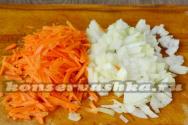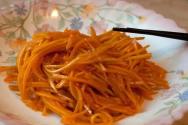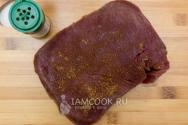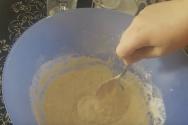Georgian dish bazhe. Bazhe - nut sauce. Products included in Satsivi
To prepare classic sauce You will also need a short list of ingredients. The basis of the dish is walnuts - take a glass with a good pile of peeled kernels to get a rich taste. You also cannot do without garlic and spices, which Georgian cuisine loves very much. Utskho-suneli, Imeretian saffron, coriander, red and black pepper will give the sauce a recognizable taste and aroma. To add the missing sourness and better reveal the aroma of the seasoning, you will need acid - it will do lemon juice or white vinegar. We will bring the sauce to the desired thickness by adding water, so do not forget to boil a couple of glasses in advance and cool until room temperature.
Bazhe's secrets
If you ask a Georgian housewife what is most important in preparing bazhe, she will tell you that you need the right ingredients and strong hands. Nuts, garlic and seasonings need to be thoroughly ground to a paste, so the main thing is to be patient and use a mortar. You can make the task easier by using a meat grinder or blender, but you will still have to work with your hands.It is very important to buy the “right” nuts. The kernels should not be bitter. Choose light colors, then the seasoning, as expected, will be colored in light nut tones. The kernels should be filled with juice, selected, and not dried out and shriveled, then they will turn out to be a good fatty paste, which means that the kernels will be tasty.
Among the seasonings in Georgian bazhe, as a rule, coriander, utskho-suneli, Imeretian saffron (marigold), hot peppers. However, in different regions of the country the proportions and set of spices may change, and if we add to this the personal preferences of each housewife, then there are countless options for the sauce, but the cooking principle is the same for everyone - grind and dilute with water. Shall we get started?

Total cooking time: 15 minutes
Cooking time: 10 minutes
Yield: 300-400 ml
Ingredients
- shelled walnuts – 1 tbsp. (100 g)
- garlic – 3 large cloves
- coriander seeds – 1/2 tsp.
- utskho-suneli – 1/2 tsp.
- Imeretian saffron – 1/2 tsp.
- salt – 1/2 tsp.
- hot red pepper – 1/3 tsp.
- black pepper – 1-2 chips.
- lemon juice – 1 tbsp. l.
- boiled water – 100-200 ml
Preparation
Big photos Small photos
Let's start with nuts. They need to be sorted out so that shell fragments do not come across.

The nuts need to be ground to a paste. To make your task easier, you can use a meat grinder or blender. The ground nuts should turn into a homogeneous mixture, fine-grained, without large pieces. It’s best to run it through a meat grinder twice, but a powerful blender with a knife attachment does the job faster, in 2-3 minutes.

I peeled the garlic, put it through a press and put it in a mortar. Salt and all the seasonings were poured there: coriander seeds, utskho-suneli, saffron, red and black pepper. I carefully ground the spices and garlic in a mortar.

Then, 1-2 spoonfuls at a time, poured ground nuts into the mortar, grinding them with a pestle to a paste.

You should get an almost homogeneous mass. If the nuts are of good quality, the mixture will be oily and will release peanut butter. Pour the resulting paste into a bowl. Add acid - I used freshly squeezed lemon juice, which can be replaced with white wine vinegar.

The mass turns out to be very thick, so it needs to be diluted with cold boiled water. Add a little at a time, literally 1 spoon at a time, thoroughly stirring the contents of the bowl. You need to add enough liquid so that the sauce has the consistency of liquid sour cream. You can make it a little thicker or thinner, but it shouldn't flow like water.

As a rule, nut sauce is served with chicken or fish, eggplant and cabbage dishes. Bazhe is placed on the table in a bowl or in a gravy boat. The sauce is poured over the dish, dipped in gomi or eaten with mchadi. It tastes hot and spicy, with a pronounced nutty taste and garlic aroma.

If you dilute it not very carefully, but choose a thick consistency, it will turn out like in the next photo. For everyone and at will. Bon appetit and delicious culinary experiments to you!

In Georgia, every housewife prepares Bazhe sauce. It is so popular and tasty that it is not only served different dishes, but they also eat it just like that - for example, with bread. The recipe is very simple and necessarily includes walnuts, garlic, suneli hops and Imeretian saffron. Don’t know what Imeretian saffron is? And these are the most common marigolds that we grow in our gardens at our dachas. Therefore, be sure to dry a few flowers, which will be useful to you in preparing this versatile and extremely tasty sauce.
Author of the publication
I was born into a family of photographers, so it didn’t take me long to choose my future profession. Journalist and photographer who worked in gloss and media for about 16 years. A tireless cook, a keen gardener and an avid traveler. Leads 3 projects on these topics. Likes simple and interesting recipes, combines incongruous things, loves to cook when traveling.
- Recipe author: Nastasya Suslina
- After cooking you will receive 300 ml
- Cooking time: 10 min
Ingredients
- 150 g walnuts
- 4 cloves garlic
- 1/8 tsp saffron
- 1/2 tsp. cilantro
- 1/2 tsp. khmeli-suneli
- 200 ml water
- 1/2 pcs. lemon
Cooking method
Prepare all ingredients. Sort through the walnuts so that there are no shell fragments. Nuts must be fresh and light in color.
Walnuts grind in a convenient way, for example, in a blender or meat grinder, but the best result is obtained by grinding it in a coffee grinder.
Peel the garlic and pass through a press, knead the dried marigolds with your fingers. Mix the nut mass with garlic, saffron, ground cilantro and suneli hops.
Add 100 ml of water and stir until smooth. Gradually add water little by little until the sauce has the consistency of liquid sour cream. This may occur in several stages so that its viscosity can be adjusted. Add the juice of half a lemon and salt to taste, stir the sauce well again.
Baje sauce ready! Store in the refrigerator for no more than 2 days. Bon appetit!
One of the pearls of world cuisine, in my opinion. Or, if you prefer, let it be a diamond. An absolute gem of Georgian cuisine. A perfect hit of newfangled vegan cuisine. Universal, divine, everyone’s and always favorite nut sauce Bazhe. If you've ever eaten satsivi, you're familiar with it. If not, I envy you, because you are on the verge of a discovery that will not leave you indifferent and will change your culinary world.
I love this sauce. But I was always afraid to approach him, because it seemed to me that he was very difficult. You know, Georgians treat him with such reverence that they flutter around him, performing some complex pirouettes. Maya Rezoevna, for example, is looking all over the city for the right nuts, so that they are young and fresh enough and do not become bitter. Marina Yuryevna prepared it for about forty minutes in complete silence and concentration. I was afraid to approach him and touch him with my crooked paws.
But it turned out that it took 10 minutes to cook. Blender. Of these, we spent 7 minutes peeling 2 cloves of garlic. The recipe was given to us by the kind Nino, a friend of my mother-in-law. She cooks divinely, as do all Georgian women and some Georgian men. Divine. We trusted her, we trusted the supermarket nuts (good nuts, not the cheapest ones), and we hit the jackpot.
Yes, and my daughter-in-law, who is a vegan, got a piece of happiness. She said, literally, that now, perhaps, this is her favorite sauce for cauliflower.
Yes. Georgians pour it thick boiled chicken(or stewed) and they call it satsivi. Another option is to cook corn grits– mamalyga (Gomi, where the “g” is pronounced softly in the Ukrainian manner), put smoked suluguni inside so that it melts, and pour this very bazhe on top. Eat your mind, eat your barrel. Okay, I'll do that for you another time. And now just like us, with rice.
Cooking time: 10 minutes
Complexity: Just
Ingredients:
cold water - 2 glasses, the water must be boiled or from a bottle, we will not cook the sauce
utskho-suneli - 1 pinch (the maximum you can replace this with is hops-suneli, without this Georgian seasoning there will be no effect, however, it’s better not to start it, that is, there will be a nut sauce, but not better; utskho-suneli sold freely in our markets)
Georgian saffron – 1 pinch (these are marigolds, in general, it has no taste, no smell, no color, you can do without it, in my opinion)
dry cilantro – 1 pinch
fresh cilantro – 3 branches (if not, it won’t work, sorry)
salt - to taste
Exit– 8 servings 
As you can see, the set of ingredients is small and quite simple. It's important to find balance in this sauce. If you don’t add Georgian spices, the sauce will be bland. If you add too many spices, they will overwhelm the taste of the nuts.
So I urge you, if you haven’t tried it before and decide to try it, do it once exactly according to the instructions, and only then experiment as much as you like, look for your own options. I don't want to change anything. Thousands of years of experience of the Georgian people have honed this sauce to perfection, it seems to me.
Fresh cilantro is very important. Dry will not give the same effect. We need juice here, spicy essential oils and a fine suspension of cilantro in the sauce.
Load everything into the blender.
And grind until smooth.
Until a homogeneous divine mass. Adjusting the salt.
The idea was this: to tell about traditional recipe satsivi. But the task of finding a classic, authentic recipe turned out to be more difficult than at first glance. One thing can be said more or less accurately: both satsivi and bazhe are not the names of the dish, but the name of the nut sauce (so you understand: satsivi has more ingredients and the preparation is more complicated, bazhe is the same thing, but simpler). Moreover, this sauce is used with poultry, meat, and even fish. But sources agree that still classic version this is satsivi with bird: turkey ( holiday dish) or chicken (a more casual option).
Then researchers and amateur cooks go into the wilds of history, trying to find out what region of the country this dish comes from and what the original recipe is. After wandering around the Internet and talking with housewives, we came to the conclusion that this dish is prepared like this: in the case of housewives, how the grandmother (mother/mother-in-law, etc.) cooked it, in the case of researchers, who likes which theory best.
To put it very briefly and discard the rare options with fish and meat, the essence of the dish is this: take the bird, cook it, pour it with nut sauce, infuse it, serve it and eat it cold. All the recipes agree on this. And then there are a million options: some boil the bird, some fry it, some bake it in the oven, some even cook it until half cooked and then finish it over charcoal. It’s the same story with the sauce: the set of spices is different, in some versions the sauce is mixed with broth, in others with water. In general, you can go crazy.
We did this: we took the most simple and quick recipe and prepared some Bazhe - satsivi-light, so to speak. Looking ahead, it turned out delicious :)
We share the recipe we used to prepare it. In general, in this version you can cook chicken in any way you like: fry, bake or boil.
So, what do you need for a “quick” satsivi (2-3 servings). If the chicken is larger, increase the proportions - especially nuts - you should never skimp on them.
- Fresh chicken, not frozen – 1-1.5 kg. (ideally young, not big, not a huge broiler)
- Walnut. At least 300-400 gr.
- Garlic 8-15 cloves (less old, more young, but generally to taste)
- Ground dry cilantro 0.5 tsp. (without top) (we didn’t have one, but it’s better to get one)
- Utskho-suneli 0.5 tsp. (without top)
- Ground red hot pepper - a pinch
- Ground white pepper - a pinch
- Ground cloves - a pinch
- Cinnamon - a pinch
- Yellow flower (saffron) - a pinch (if in powder, then more)
We salted and peppered the chicken (you rub the carcass with your hands), cut it along the breast, and fried it whole in a frying pan under pressure - in the manner of “tabaka” chicken. It is important not to overcook - when punctured, a little white juice should flow out (if red juice flows out, it’s not ready). Fry it on both sides and leave it to cool (covered so it doesn't dry out).
If you bake, you need to water it with juice, otherwise it will dry out. If you cook, add a little salt, you can add fresh herbs to the pan in one bunch: cilantro, parsley, a sprig of basil. Do not cut the greens, you will need to pull them all out later.
Prepare the sauce. Carefully sort the nuts: discard all internuclear plates, get rid of any dried and transparent nuts when scrapped. If you don’t overdo it, the sauce will be bitter.
Grind the nuts into dust. If you use a meat grinder, then skip it 2-3 times; if you use an electric grinder, then it’s easier – just press the button hard and you’re done :)
Peel the garlic, grind it in the same way as with nuts - into dust. You can use a garlic press.
Throw the garlic into the nuts, add spices: utskho-suneli, red and white pepper, cinnamon, dry cilantro (if found), cloves, saffron. Salt it a little. We didn’t have cilantro, we sprinkled in a little cardamom – on our own, not as part of the recipe. He didn’t ruin the matter :)
The proportion of spices indicated above is very light. If you love someone stronger, spicy taste, add more. The basis of the taste is here: utskho-suneli, cilantro. You can increase the portion of cinnamon + pepper - it turns out interesting. Taste the mixture and adjust the taste.
Next you need to work with your hands for about 15 minutes. Knead the mixture thoroughly, press it, knead it, knead it - eventually the nut oil should begin to separate, and the mixture should become homogeneous (it is still dry, so you won’t get a creamy mixture, but after kneading, there will be lumps break everything).

Slowly begin to add water - 2-3 tablespoons to start. Stir again with your hands and press in the water. The mixture should become homogeneous, without lumps or dry spots, and begin to turn white - this is the nut oil reacting with water. If it doesn’t turn white, it’s bad - knead it harder so that the oil is released.
In the same way, little by little, we continue to pour in water - a maximum of a third of a glass at a time. Stir with your hands all the time - the water should not hang out separately, the mass becomes thinner, but remains homogeneous.
In total we poured in about 0.5 liters of water. If you have more nuts and spices, add more. The consistency should be no thinner than pancake batter. Maybe a little thicker. The sauce should pour out of the spoon, but not be liquid. Taste and adjust salt, pepper and garlic. Add some of the spices if you really want to. At the end we added more garlic and fresh parsley – chopped.
Accordingly, if you boiled the chicken rather than fried it, you can use broth instead of water to dilute the sauce. Just let it cool first.

The sauce turned white and became the desired consistency. The chicken is ready. Cut it into portions, place in a mold, pour in the sauce (it should completely cover all the pieces). Place in a cool place (or refrigerator). Ideally, the dish should sit for several hours - then the meat will be saturated with the sauce and will be more interesting.
The dish is not heated when serving. But it shouldn’t be icy either - take it out of the refrigerator before eating - let it be at room temperature. Garnish with herbs or pomegranate seeds.
Traditionally, satsivi and bazhe are served with lavash or gomi ( corn porridge). This time we made do with delicious Georgian tomatoes. It's delicious, try it!
The wine is white dry. The best thing is Georgian, ideally young homemade.
Bazhe sauce, my great-grandmother pronounced it “bazha,” is a universal nut-garlic sauce of Georgian cuisine. The sauce is spicy, spicy and at the same time tender, very tasty. In addition, this water sauce is vegan and meatless. Walnut-garlic sauce Bazhe goes well with vegetables, poultry and fish dishes. Along with the sauce, my family really likes bazhe, based on the Armenian skhtor-matsun. All Caucasian cuisine recipes- By .
Compound:
- Walnuts - 1 cup
- Garlic - 3-4 cloves
- Utskho-suneli spice (fenugreek) - 1/2 teaspoon
- Imereti saffron - on the tip of a knife
- Coriander - 1/2 teaspoon
- Ground black pepper, red hot pepper, salt - to taste
- Wine vinegar or lemon juice - 1 tablespoon
- Water - 1 glass
How to make nut garlic Georgian sauce Bazhe, a universal seasoning for vegetables, poultry or fish dishes
Walnuts should be as light as possible and of excellent quality. The sauce should be almost white.
Place walnuts and peeled garlic in a blender
Grind the nuts and garlic in a blender into a paste. Good, fresh nuts make the paste slightly oily and almost smooth.
 Grind nuts and garlic into a smooth paste
Grind nuts and garlic into a smooth paste Transfer the nut-garlic paste from the blender. Add chilled boiled water and dilute the sauce to the desired thickness. Add water little by little, a tablespoon at a time, and stir the sauce. Usually the bazhe sauce is diluted to the consistency of medium-fat sour cream.
 Add water and stir the sauce to the desired consistency
Add water and stir the sauce to the desired consistency Add light wine vinegar or freshly squeezed lemon juice. I like it better with lemon juice.
 Add vinegar or lemon juice and stir
Add vinegar or lemon juice and stir Add spices, salt the sauce to taste, mix thoroughly.
 Add spices, salt to taste
Add spices, salt to taste Bazhe nut-garlic vegan sauce, a popular seasoning in Georgian cuisine, is ready.
 Baje sauce (baja)
Baje sauce (baja) My favorite thing is Bazhe sauce with cold chicken, boiled fish And







